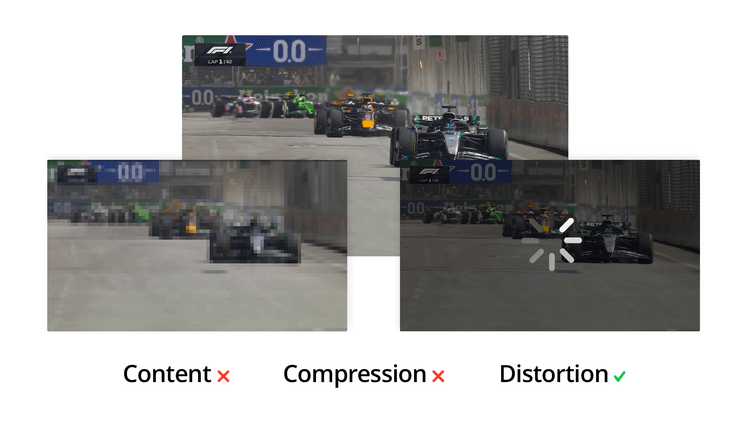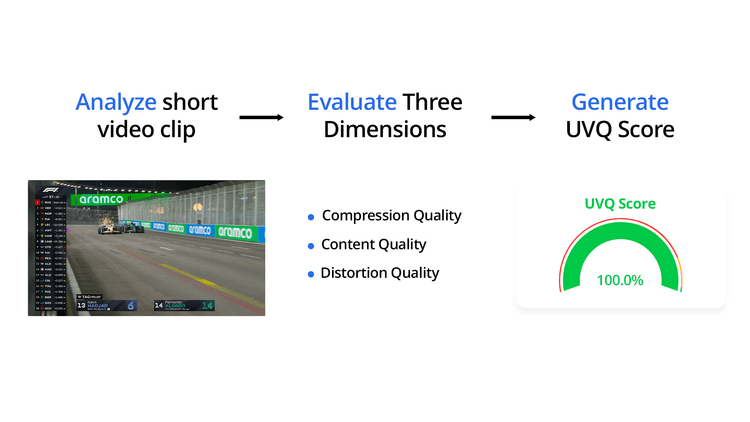- QA test automation
- Video service monitoring
- Quality benchmarking
Industry-standard video quality measurement: UVQ with Witbe
By Witbe
When streaming services compete for viewers, video quality becomes a deciding factor. To stay ahead, providers need more than smooth playback. They need metrics.
At Witbe, we continue to expand our testing and monitoring toolbox with support for industry-standard metrics such as UVQ (Universal Video Quality), developed by YouTube Research.
What is UVQ?
Definition of UVQ

UVQ (Universal Video Quality) is a non-reference video-quality metric designed to evaluate short clips with exceptional precision. UVQ analyzes short segments of video offline to assess three core dimensions:
• Content quality — evaluating how visual details are preserved.
• Compression quality — detecting artifacts introduced by encoding.
• Distortion quality — identifying degradation from processing or delivery.
Developed by YouTube Research and trusted across the streaming ecosystem, UVQ provides a consistent, cross-platform benchmark for measuring perceived video quality.
Learn more about UVQ on Google Research →

Technical highlights of UVQ
UVQ was designed with a specific focus on user-generated content and is optimized for analyzing short video samples. Its strengths include:
- Best for short clips between 20 seconds and 1 minute
- Tailored for the challenges of user-generated and platform-driven content
- Provides KPIs for:
- MOS scoring
- Content quality
- Compression quality
- Distortion quality
Complementary to Witbe VQ-MOS and VQ-ID
While UVQ delivers standardized scores, Witbe VQ-MOS and VQ-ID measure how video actually performs on real devices in real time:
- Witbe VQ-MOS analyzes perceived video and audio quality, detecting blurriness, blockiness, jerkiness, or sound imbalance to provide a Mean Opinion Score (MOS).
- Witbe VQ-ID acts as a rapid-response layer, flagging visible degradations like freezes, black screens, buffering, upscaling, or severe compression so operations teams can react immediately.
Together, they combine UVQ’s benchmark precision with Witbe’s live playback insight, offering a complete, multi-layer understanding of video quality.
Integrated within the Witbe Suite
UVQ is seamlessly integrated into the Witbe Software Suite:
- Smartgate performance dashboards: Centralize results and display UVQ KPIs with Witbe VQ-MOS scores

- Virtual NOC for remote monitoring: Provide collaborative visibility for QA and operations teams anywhere in the world
- Witbox testing robots: Run tests on Smart TVs, STBs, mobile phones, and web browsers exactly as real users experience them
To ensure accurate, end-to-end validation, Witbe’s UVQ analysis runs directly on real consumer devices across a broad range of hardware.
This includes tests on Android TV and Comcast RDK set-top boxes, monitoring on Apple TV, Amazon Fire TV, Google Chromecast, and leading gaming consoles such as PlayStation 5 and Xbox.
By testing on the actual platforms where subscribers watch content, Witbe ensures that UVQ results truly represent the end-user experience; from the living room to connected entertainment hubs worldwide.
Why it matters
By combining UVQ’s industry-recognized benchmark with Witbe’s real-device testing and monitoring, video service providers gain the most reliable, transparent, and actionable view of their video quality; both in controlled environments and at scale.
At Witbe, we keep building the strongest toolbox for video service providers, blending industry standards and real-world performance to ensure every stream meets the highest standards of quality.



